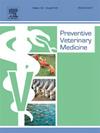Assessing trends in ectoparasiticidal drugs used to control ticks and flies in farm animals: A four-year analysis reveal differences between epidemiological zones at country level in Uruguay
IF 2.2
2区 农林科学
Q1 VETERINARY SCIENCES
引用次数: 0
Abstract
The use of ectoparasiticides is a major concern in the control of parasites. In this study, we examined the trends and patterns of veterinary medicines use comparing between a high-risk epidemiological zone (HRZ) and a low-risk epidemiological zone (LRZ) for ectoparasites over a four-year period (2017–2020) at country level data. The objective of this study was to analyze the patterns of ectoparasiticide use in Uruguayan cattle, using the Anatomical Therapeutic Chemical Classification System for Veterinary Drugs (ATCvet) and dose indicators to consider regional variations in the animal population and production intensity. A total of 222 registered products classified as acaricides and/or insecticides based on 21 different active ingredients were grouped into 8 ATCvet level 4 categories. The annual consumption of active ingredients in ectoparasiticides averaged 40.6 tons. The total volume in the HRZ was 693 % higher than in the LRZ. The most sold ATCvet groups were Amidines (55.9 %), Pyrethrins/Pyrethroids (20.7 %), and Organophosphate Compounds (7 %). We calculated four different indicators with the resulting median values for entire country: 89.3 Technical Units per 1000 kg (IQR range of 10.5), 0.15 mg/kg of dosing biomass, 45.7 mg/ha of dose grazing area, and 3.09e+ 10 mg/LU/ha, respectively. Amidines were the most used group in the HRZ across all indicators, while Carbamates and Pyrethrins/Pyrethroids dominated in the LRZ. Cypermethrin, Amitraz, and Ethion were predominant in the HRZ, while Cypermethrin, Carbaryl, and Diazinon were common in the LRZ. The analysis of the four mixed Generalized Linear Models revealed significant differences in the use of veterinary medicines between zones with varying levels of epidemiological risk for parasitic diseases, with certain categories showing consistent patterns between indicators and zones. These results highlight the complexity of a veterinary medicine usage and the need for specialized strategies in veterinary medicine to address regional differences in the use of parasitic agents.
评估用于控制农场动物中蜱虫和苍蝇的体外寄生虫药的趋势:一项为期四年的分析揭示了乌拉圭国家一级流行病学区之间的差异。
外驱虫剂的使用是控制寄生虫的一个主要问题。在这项研究中,我们通过国家层面的数据,比较了4年(2017-2020年)期间(高危流行病学区(HRZ)和低风险流行病学区(LRZ)体外寄生虫的兽药使用趋势和模式。本研究的目的是利用兽药解剖治疗化学分类系统(ATCvet)和剂量指标,分析乌拉圭牛体外驱虫剂的使用模式,以考虑动物种群和生产强度的区域差异。共有222种登记产品根据21种不同的有效成分被分类为杀螨剂和/或杀虫剂,被分为8个ATCvet 4级类别。除虫剂有效成分的年消费量平均为40.6吨。HRZ的总积比LRZ高693 %。销售最多的ATCvet类是脒类(55.9 %)、拟除虫菊酯/拟除虫菊酯类(20.7 %)和有机磷酸酯类(7 %)。我们计算了四个不同的指标,并得出了全国的中位数:89.3技术单位/ 1000 kg (IQR范围为10.5),0.15 mg/kg剂量生物量,45.7 mg/ha剂量放牧面积和3.09e+ 10 mg/LU/ha。在所有指标中,酰胺类是HRZ中使用最多的一类,而氨基甲酸酯类和除虫菊酯/拟除虫菊酯类在LRZ中占主导地位。高岭区以氯氰菊酯、阿米特嗪和乙硫磷为主,低岭区以氯氰菊酯、威威利和二嗪农为主。对四种混合广义线性模型的分析显示,在寄生虫病流行病学风险程度不同的地区之间,兽药的使用存在显著差异,某些类别在指标和地区之间显示出一致的模式。这些结果突出了兽药使用的复杂性和兽药专门战略的必要性,以解决寄生虫剂使用的区域差异。
本文章由计算机程序翻译,如有差异,请以英文原文为准。
求助全文
约1分钟内获得全文
求助全文
来源期刊

Preventive veterinary medicine
农林科学-兽医学
CiteScore
5.60
自引率
7.70%
发文量
184
审稿时长
3 months
期刊介绍:
Preventive Veterinary Medicine is one of the leading international resources for scientific reports on animal health programs and preventive veterinary medicine. The journal follows the guidelines for standardizing and strengthening the reporting of biomedical research which are available from the CONSORT, MOOSE, PRISMA, REFLECT, STARD, and STROBE statements. The journal focuses on:
Epidemiology of health events relevant to domestic and wild animals;
Economic impacts of epidemic and endemic animal and zoonotic diseases;
Latest methods and approaches in veterinary epidemiology;
Disease and infection control or eradication measures;
The "One Health" concept and the relationships between veterinary medicine, human health, animal-production systems, and the environment;
Development of new techniques in surveillance systems and diagnosis;
Evaluation and control of diseases in animal populations.
 求助内容:
求助内容: 应助结果提醒方式:
应助结果提醒方式:


